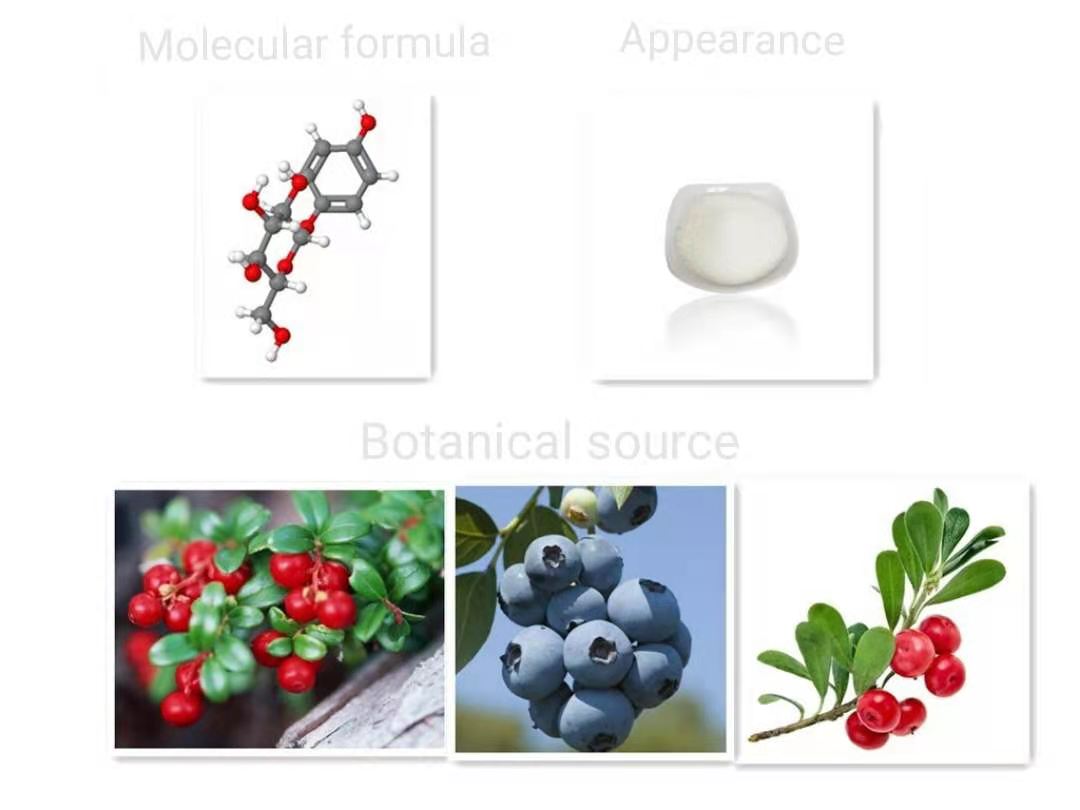Skin white Anti-Freckle agent Arbutin
Introduction
Arbutin, (hydroquinone-O-beta-D-glucopyranoside) a naturally occurring -d-glucopyranoside derivative of hydroquinone. The hydroquinone glucoside is a botanically derived compound found in certain plant species, such as bearberry, cranberries, blueberries, wheat, pears and the fresh fruit of the California buckeye, Aesculus californica. The active component, hydroquinone, is released by the hydrolysis of the glucoside fraction. As it is released slowly, the use of arbutin may be less irritating than using hydroquinone directly. The mild effect of arbutin is attributed to the controlled release of hydroquinone as a result of in-vivo cleavage of the glycosidic bond. Arbutin is present in 2 forms, namely alpha and beta-arbutin. It appears that alpha-arbutin offers higher stability and efficacy compared to the beta form.
Mode of action
Arbutin exerted its effect through a controlled release of hydroquinone by the in vivo hydrolysis of the glycosidic bond. It is reported by various researchers to inhibit the oxidation of L-DOPA catalysed by mushroom tyrosinase. A study indicated that arbutin inhibits melanin synthesis by inhibition of tyrosinase activity. This appears to be due to the inhibition of melanosomal tyrosinase activity and Pmel-17 protein at noncytotoxic concentrations rather than the suppression of this enzyme’s synthesis and expression. It also inhibits the maturation of melanosomes, possibly by its reported influence on DHICA (5,6-dihydroxyindole-2-carboxylic acid) polymerase activity. It is thought that the activity of arbutin is driven by the structural homologies that it shares with the substrate tyrosine. It was showed that arbutin inhibits the oxidation of L-tyrosine (monophenolase activity) catalysed by mushroom tyrosinase and that it competes for active binding sites in tyrosinase without influencing the mRNA transcription of tyrosinase or being oxidized. However, arbutin itself was oxidized as a monophenol substrate at an extremely slow rate, and the oxidation was accelerated as soon as catalytic amounts (0.01 mM) of l-3,4- dihydroxyphenylalanine (L-DOPA) became available as a cofactor.
Types of arbutin
Arbutin is commercially used as a skin-whitening agent in cosmetic industry. It works by competitive inhibition of the enzyme, tyrosinase, a key enzyme in the synthesis of melanin.Depending on the spatial structure of the glycosidic linkage between glucose and hydroquinone, arbutin forms two epimers: Alpha Arbutin and Beta arbutin.
| Item | Alpha-Arbutin | Beta-Arbutin |
| Appearance | White Crystalline Powder | Crystalline white powder |
| Assay | 99.0% min. | 99.5%min |
| Melting point | 202~207℃ | 198.5~201.5℃ |
| Clarity of water solution |
Transparency,colorless,none suspended matters |
Transparency, colorless, none suspended matters |
| pH value of 1% aqueous solution | 5.0~7.0 | 5.0~7.0 |
| Specific optical rotation | 【ɑ】D20=+176~184° | 【α】D20=-66±2º |
| Arsenic | ≤2 ppm | ≤2 ppm |
| Hydroquinone | ≤10 ppm | ≤10 ppm |
| Heavy metal | ≤10 ppm | ≤10 ppm |
| Loss on drying | ≤0.5% | ≤0.5% |
| Ignition residue | ≤0.5% | ≤0.5% |
| Pathogen | Bacteria:≤100cfg/gFungus: ≤100 cfu/g | Bacteria:≤300cfu/gFungus:≤100cfu/g |
Function
1. Skin lighten, Whiten and dispell fleck
2. Prevent ultraviolet radiation
3.Enhance immune system
4. Be good for our enteric disease
5. Has antiphlogistic and analgesic function to burn and scald
Post time: Jan-21-2021


